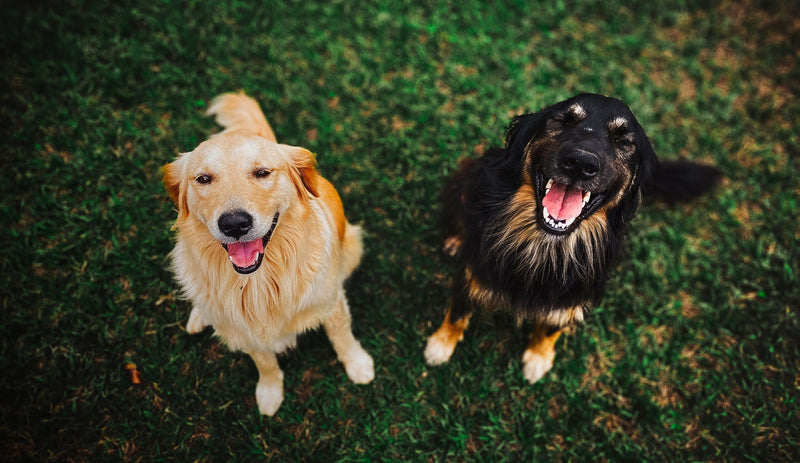As a responsible pet owner, ensuring the best care for your dog is at the heart of everything you do. Among your many responsibilities, safeguarding your pup’s dental health is becoming an increasingly important job. Just like with people, a pet's dental health is paramount to their overall well-being. As a result, regular teeth cleaning has become a non-negotiable part of their care routine.
But why should we be concerned with cleaning our dog's teeth in the first place? What’s the worst that could come from some dirty chompers?
Understanding Dental Tartar (It’s plaque. Rock hard plaque)
Tartar is primarily composed of bacteria and is a bit of a villain in our pets' oral health story. When allowed to accumulate on and under their teeth, it can potentially cause substantial damage to the gums, bone, and ligaments that hold the teeth in place. Just like the gunk that a dentist removes from your own teeth, tartar for your pet is an extremely hard and coercive substance that can only be effectively removed by carefully scraping it away.
While this might not sound that bad, the risks of unmitigated tartar build up don't stop at lumpy teeth. At best, excessive tartar could cause gum disease and rotting teeth. At worst, bacteria from tartar can find their way into the bloodstream and negatively affect vital organs such as the liver, kidneys, and heart.
All that from teeth that are not cleaned regularly enough.
Yes, this is a scary thought; however, our goal here isn’t to worry you. We just want to highlight the importance of regular teeth cleaning, which is the only sure way to prevent this tartar buildup. Without regular teeth cleaning, your dog is much more at risk of developing periodontal disease, and the subsequent serious health issues it can cause if left unchecked.
So let’s talk about cleaning some teeth.
The Importance of Regular Dental Care
While daily routines such as brushing your dog's teeth with dog-specific enzymatic toothpaste and offering dental chews are good policies, for most dogs this won’t be enough. Eventually, your dog is likely to need a professional dental cleaning. This is where we might lose many dog owners. Because traditionally, this procedure involves putting the dog under anesthesia.
We know, we know, add the word “vet” to “anesthesia” and you get a “bill.” But don’t click away just yet because we can point you toward a more accessible solution.
The past few years have seen the emergence of a popular alternative option: Professional Outpatient Preventive Dentistry (POPD) more commonly known as anesthesia-free teeth cleaning. This method involves a thorough cleaning of your dog's teeth while they're fully awake. Its popularity is mainly due to its less invasive nature and more affordable costs compared to traditional anesthetized cleanings.
And the best part? Our veterinary partners offer these teeth cleanings at our regular, in-store vet clinics!
Want to know more? We have the inside scoop, the pros, the cons, and the nitty-gritty details of how to take advantage of this service at your local Kahoots.
View Our Upcoming Dental ClinicsAnesthesia-Free Teeth Cleaning: What is it and How Does it Work?
Anesthesia-free teeth cleaning, also known as non-anesthetic dental cleanings (NADs), is a procedure performed without the use of general anesthesia. So no bloodwork, IV, or prolonged recovery time needed.
During this procedure, a veterinary technician uses a specialized tool to gently break apart tartar and scrape it away from your pet’s teeth. They perform this procedure both on the surface of the tooth and under the gumline. This method is considered less invasive and more affordable than traditional anesthetized cleanings. Though to be fair, while this innovative field has seen rapid growth, and although we've seen firsthand how it can benefit pets and their owners alike, it's still met with a little skepticism from some in the veterinary world.
The hesitancy around NADs stems from cleanings that were performed without veterinarian supervision, which occasionally resulted in health issues for the dog. Technicians without adequate training often missed vital signs of serious health conditions like heart disease, putting pets at risk. This experience led some veterinarians to disapprove of NADs. However, California law now mandates a veterinarian to physically examine the patient before any procedure, and the vet’s supervision during NADs, increasing safety and acceptance among professionals.
While there have been concerns in the past about the safety and efficacy of anesthesia-free teeth cleaning, it's essential to recognize the numerous benefits this method offers when performed correctly and under the right conditions. Let's delve into the advantages of opting for non-anesthetic dental cleanings for your pet
Benefits of Anesthesia-Free Teeth Cleaning
Less invasive for pets: Since there is no need for anesthesia, the procedure is less traumatic and less invasive for your pet, requires no prolonged recovery time, and eliminates any risk of complications related to anesthesia.
More affordable: Anesthesia-free teeth cleaning is generally less expensive than traditional anesthetized cleanings. Not needing to run blood tests, intubate your pet, and require multiple professionals to perform a single procedure keeps the cost down. As a result, NADs are usually a more affordable (and accessable) option for pet owners.
Faster procedure time: Our veterinary partners report that non-anesthetic cleanings can be completed in as little as 20 minutes, with no recovery time needed.
More suitable for pets with health concerns: Anesthesia-free teeth cleaning may be a safer option for pets with medical conditions that make anesthesia risky.
Can reveal hidden disease: During NAD's, the veterinarian is more likely to discover dental or oral health issues that otherwise may go unnoticed between regular vet visits
Limitations of Anesthesia-Free Teeth Cleaning
Potential for non-candidacy: Certain dogs with especially bad teeth, or adult dogs that have never had a teeth cleaning, may have significant tartar buildup and even disease underneath their teeth. These dogs are not good candidates for NAD. Instances like these will be discovered by the veterinarian in the pre-procedure checkup and typically result in a referral for a more intensive procedure at a veterinary hospital.
Risk of minor injury: Since your pet is awake during the procedure, there is a small risk of injury to both the pet and the technician if the pet moves unexpectedly. This is why pets that have infections or anxiety aren’t considered good candidates for NADs. Pets that are aggressive or have severe pain around their mouth would also generally require an anesthetized procedure at a veterinary hospital.
No dental X-rays: Anesthesia-free cleanings do not include dental X-rays, which are essential for detecting dental issues below the surface. While the veterinarian who oversees the cleaning will do an examination to detect any obvious signs of disease, there is only so much that can be seen on the surface.
Anesthetized Teeth Cleaning: Benefits and Risks
Anesthetized teeth cleaning is a comprehensive dental cleaning that requires your dog to be under general anesthesia. This method allows for a complete examination and cleaning of the teeth. Dental X-rays are also commonly taken during anesthetized cleanings to assess the overall oral health of your pet.
Benefits of Anesthetized Teeth Cleaning
Thorough cleaning: Anesthetized cleanings provide a comprehensive cleaning of your pet's teeth, including the areas that may be inaccessible without anesthesia due to infection, pain, or uncooperative patient.
Pain-free experience (for the extreme cases): Since your pet is under general anesthesia, they will not experience any pain or discomfort during the procedure regardless of infection, pre-existing injuries, or stress levels of the pet. This is important for those pets who are not good candidates for NADs because a non-anesthetic treatment (which is pain free for a healthy pet) would be too uncomfortable for them to sit through easily.
Dental X-rays: Anesthetized cleanings include dental X-rays, which are essential for detecting dental issues that may not be visible during a regular oral examination.
Risks of Anesthetized Teeth Cleaning
Anesthesia-related complications: Although anesthesia is considered safe for most pets, there is always a risk of complications, such as low blood pressure, decreased heart rate, and shallow breathing.
Cost: Anesthetized teeth cleanings can be more expensive than anesthesia-free cleanings, with costs can range from $600 to $1,200 depending on the procedure.
Recovery time: Your pet may require a recovery period following the procedure, during which they may experience lethargy and grogginess.
Anesthesia-Free Teeth Cleaning at Kahoots Vet Clinic Events
At the monthly or semi monthly vet clinic events we host at most of our local stores, we're proud to offer non-anesthetic dentals (NADs) through our vet services partner.
The process is straightforward. Our veterinarian partners secure your pet comfortably in their lap—if they're smaller in size, the dog is wrapped in a towel for added comfort and security. The technician gently holds the pet's muzzle while skilfully scaling away tartar with either a hand scaler or ultrasonic device. The mouth is kept open with a rolled-up paper towel, and the cleaning ends with a thorough polish.
It’s important to reiterate that not all pets are candidates for NADs.
Uncooperative behavior, aggression, or severe dental disease can disqualify a pet from this procedure. For instance, small, older dogs that have never had a dental cleaning and have severe dental disease require anesthetized cleanings to address their issues effectively and painlessly.
The ideal candidates for NADs are young, well-behaved dogs (and they can also clean your cat’s teeth too!), preferably around two years old. As part of the process, owners must fill out a chart and sign a waiver before the dental cleaning is performed. To ensure optimal dental health, these cleanings are recommended every six months.
If you are interested in having your pet’s teeth cleaned, find the next vet clinic at a location near you and come in for a visit to schedule your appointment!
Wrapping Up
Your dog’s dental health is an essential part of their overall well-being. As pet parents, it's our responsibility to ensure that they receive the best care possible, and that includes regular dental check-ups and cleanings. With the advent of anesthesia-free teeth cleaning, it's now possible to provide our pets with a less invasive, more affordable, and quicker dental cleaning option.
However, this procedure comes with its own set of pros and cons. It's essential to consider the limitations and have a comprehensive understanding before deciding on the best dental health path for your pet. Whether you opt for traditional anesthetized cleanings or the innovative non-anesthetic dental cleanings, the ultimate goal is the same: to keep your pet's mouth healthy and their tails wagging.


